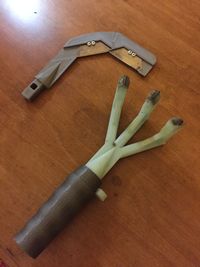Interchangeable Garden Tools
Project developed by Ldstetsk
Template:Statusboxtop Template:Status-design Template:Status-prototype You can help Appropedia by contributing to the next step in this OSAT's status. Template:Boxbottom
Abstract
A few students from previous classes created smart and creative tools that could be used anywhere in the world for many different applications. I took it upon myself to create a universal, ergonomic handle, and update those tools to interchange easily with my handle.

Bill of Materials
- Handle - 32g - 2.5 hours
- Pin - 2g - 15 minutes
- Pruning Hook - Based off Hannah Power's Pruning hook - 29g - 2 hours
- (2) Stanley Heavy Duty Utility Blades (10 for $6.14) http://www.amazon.com/gp/product/B0006HVTSO?keywords=heavy%20duty%20razor%20blades&qid=1449560989&ref_=sr_1_2&sr=8-2
- (4) 3MM nuts and bolts
- Cultivator Rake - Based off Matthew Andres' Hand cultivator - 66g - 5 hours
Source file from FreeCAD
File:InterchangeableGardenTools.fcstd
All STLs Link title Link title Link title Link title
Tools needed for fabrication of the OSAT
- MOST Delta RepRap or similar RepRap 3-D printer
- Philips Screwdriver
- Pliers to Tighten Nuts
- Sandpaper for minor sanding to ensure perfect fits into handle
Skills and Knowledge Necessary to Make the OSAT
- Slicing Software such as Cura
- Open Source CAD software such as FreeCAD
Technical Specifications and Assembly Instructions
The following are the setting I used to print each piece. These may not be the optimal settings, but the final pieces work perfectly
- Handle - 32g filament - 2.5 hours to print
Infill: 10% Layer Height: 0.2 mm Shell Thickness: 1.5 mm Bottom and Top Thickness: 1.5 mm
- Pin - 2g filament - 15 minutes to print
Infill: 10% Layer Height: 0.2 mm Shell Thickness: 1 mm Bottom and Top Thickness: 1 mm
- Pruning Hook - Based off Hannah Power's Pruning hook - 29g filament - 2 hours to print
Infill: 50% Layer Height: 0.2 mm Shell Thickness: 1.5 mm Bottom and Top Thickness: 1.5 mm
Cultivator Rake - Based off Matthew Andres' Hand cultivator - 66g filament - 5 hours to print Infill: 50% Layer Height: 0.2 mm Shell Thickness: 1.5 mm Bottom and Top Thickness: 1.5 mm
Common Problems and Solutions
I had an issue we parts pealing off the bed, especially the cultivator head. I printed it again with a brim and no issue
Cost savings
- $3.25 in PLA filament
- $1.50 in nuts and bolts from hardware store
- $1.23 for 2 utility blades
$4.63 Total
Commercial Equivalent Pruning Knife - $15.74 [1] Cultivator Rake -
- Calculate $ savings and % savings
References
- The sources of information (e.g. engineering handbooks, journal articles, government documents, webpages, books, magazine articles etc.). References should use the <ref> </ref> and <references/> tags and can be in any format but should include all the information necessary for someone else to find the same information you did. For example: [1]
- ↑ web page: Department of Energy (DOE) Landscaping and Energy Efficiency, DOE/GO-10095 (1995) Available: http://www.eren.doe.gov/erec/factsheets/landscape.html
Based on the developmental needs addressed (e.g. food, heat, electricity, clean water, health care, etc.) be sure to label your device in the proper categories e.g. use [[Category:Water]]. Be sure to categorize your device so that it will be easy to find – for example “Low voltage connection basics” is categorized in [[Category:How tos]] [[Category:Electricity]] [[Category:Electric lighting]].